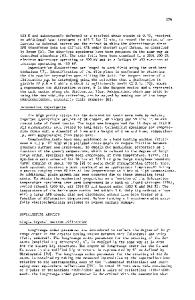Phase transitions in stable nanocrystalline alloys
- PDF / 613,157 Bytes
- 10 Pages / 584.957 x 782.986 pts Page_size
- 82 Downloads / 363 Views
Grain boundary segregation can reduce the driving force for grain growth in nanocrystalline materials and help retain fine grain sizes. However, grain boundary segregation is enthalpically driven, and so a stabilized nanocrystalline state should undergo a disordering process as temperature is increased. Here we develop a Monte Carlo-based simulation that determines the minimum free energy state of an alloy with a strong tendency for grain boundary segregation that considers both different grain sizes and a large solute configuration space. We find that a stable nanocrystalline alloy undergoes a disordering process where grain boundary segregated atoms dissolve into the adjacent grains and increase the grain size as a function of temperature. At a critical temperature, the single crystal state becomes the most preferred. Using this method, we are able to determine how the grain size changes as a function of temperature and produce equilibrium phase diagrams for nanocrystalline alloys. I. INTRODUCTION
Stabilizing nanocrystalline materials against grain growth is a critical bottleneck to their reliable use as bulk components. Pure nanocrystalline materials undergo rapid grain growth into micron-scale grain sizes at relatively low homologous temperatures,1–4 but with the addition of alloying elements grain growth can be greatly hindered.5–13 Two mechanisms for suppressing grain growth by alloying have been proposed: alloying elements can either kinetically impede grain growth by increasing the activation energy for grain boundary motion (effectively decreasing grain boundary mobility) or decrease the grain boundary energy thermodynamically through grain boundary segregation (or both). The latter mechanism is particularly promising, as substantial decreases to the grain boundary energy from grain boundary segregation could stabilize nanoscale grain sizes to higher temperatures and for longer times.8–13 There is an even more enticing prospect when alloying to reduce the grain boundary energy: if the excess energy of the grain boundary is eliminated by grain boundary segregation, grain growth can be entirely avoided and a thermodynamically stable grain size in the nanocrystalline regime could exist. This concept was put forth by Weissmüller,14,15 with an accompanying analytical model that revealed that a system with an enthalpy of grain boundary segregation large enough to offset the pure grain boundary energy should have such a stable nanocrystalline Contributing Editor: Jürgen Eckert a) Address all correspondence to this author. e-mail: [email protected] This paper has been selected as an Invited Feature Paper. DOI: 10.1557/jmr.2017.188
state. Further analytical models have been developed, for example improving on assumptions that only applied in the dilute limit by incorporating the energy of solute– solvent interactions both in the grain boundary and in the crystal using a regular solution model.16–19 Such efforts have produced alloy design criteria for identifying potential alloy systems with thermodynamically stable nano
Data Loading...










